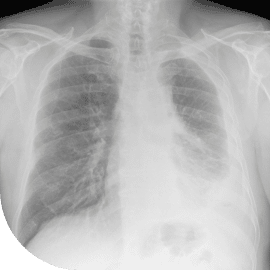Asbestosis
Home » National Mesothelioma Law Firm » Mesothelioma Cancer » Asbestosis
Medically Reviewed By:
Patricia Shelton, M.D.
- Page Last Updated:
- January 23, 2024
Medically Reviewed By:Patricia Shelton, M.D.
- Page Last Updated:
- January 23, 2024
Asbestos exposure can cause a variety of different diseases, including mesothelioma and lung cancer. It can also cause asbestosis, in which scarring of the lung tissue causes the lungs to become stiff, leading to difficulty breathing. There is no known way to stop the progression of asbestosis, but symptomatic treatments can be helpful.
What is asbestosis?
Asbestosis is a chronic lung disease caused by inhaling asbestos fibers in large quantities and over a long period of time. Asbestos is a natural mineral that tends to break apart into microscopic fibers and become aerosolized. The fibers are so small that they can’t be seen in the air.
When these fibers are inhaled, they can become embedded in the lung’s alveoli, which are the tiny air sacs at the end of the airways. The body’s immune system then attempts to break down and remove these foreign fibers, initiating an inflammatory response. However, asbestos is an extremely stable mineral, and the body is unable to break it down.
The asbestos fibers irritate and scar the lung tissue. As asbestosis progresses, more lung tissue is scarred. Over time, the scarred tissue makes the lungs stiff and unable to expand normally, which makes it difficult to breathe.
Asbestosis is a type of interstitial lung disease, which is characterized by inflammation and scarring of lung tissue that prevent your lungs from getting enough oxygen. This kind of scarring is called pulmonary fibrosis. You may see these terms used in your medical record to describe your asbestosis.

Is asbestosis a type of cancer?
Asbestosis itself is not a type of cancer. It is a chronic disease which is progressive and can be fatal in some cases. However, it will not spread through the body, as cancer often does.
People with asbestosis are at risk for developing asbestos-related cancers, however, including mesothelioma and lung cancer. This is because the presence of asbestosis indicates that a person has been exposed to significant quantities of asbestos.
The amount of asbestos exposure it takes to cause asbestosis is also enough to cause a significantly increased risk of cancer. For example, smoking greatly increases the risk that a person with asbestosis will develop lung cancer.
What are the risk factors for developing asbestosis?
The primary risk factor for developing asbestosis is asbestos exposure. Workplace exposure is the most common. Since the Environmental Protection Agency (EPA) started regulating asbestos in the United States in 1989, high levels of exposure have become less common.
However, due to a long latency period between exposure to asbestos and the development of asbestosis, people can develop the disease due to an exposure they had decades ago when asbestos was less regulated than it is now.
Historically, workplace exposures are most common among the following occupations:

Roofers

Steamfitters

Welders, and more
According to the American Lung Association, the main group at risk is people who worked in manufacturing, milling, mining, or installation or removal of asbestos products before the late 1970s. It is less likely for someone to develop asbestosis today, but exposure is still possible in the construction trade when working with old equipment or demolishing/renovating older buildings.
Studies have shown that people who are exposed to asbestos at higher levels or for a long period are at a higher risk for developing asbestosis. In general, it takes a significant amount of asbestos exposure to lead to asbestosis. The amount of asbestos required to cause asbestosis is higher than the amount that causes mesothelioma.
Data from the National Institute of Occupational Safety and Health, as reported by the Agency for Toxic Substances and Disease Registry, showed that the deaths caused by asbestosis increased significantly from the 1960s to the 2000s, and is expected to continue occurring for decades.
- In the past, household contacts of asbestos workers were exposed to asbestos dust carried home on workers’ skin and clothing.
- People in homes and buildings with loose, crumbling, or disturbed asbestos materials can be exposed to asbestos.

What are the symptoms of asbestosis?
It can take 10 to 40 years after asbestos exposure for asbestosis symptoms to become apparent. This is because scar tissue takes time to build up in response to the presence of asbestos fibers in the lungs.
Common types of asbestosis symptoms:
- Shortness of breath
- Dry cough
- Chest pain, which may radiate to the shoulder
- Dry or crackling sounds when inhaling
- A rounded appearance to the fingertips and toes, known as clubbing
- Extreme fatigue
How is asbestosis diagnosed?
The diagnosis of asbestosis begins with careful documentation of medical history. Your doctor will need to know about your work history, including any potential asbestos exposure you may have had. Your symptoms, medical history, and history of asbestos exposure will strongly suggest the diagnosis of asbestosis.
To confirm the diagnosis, certain tests may be used:

Chest X-ray: This can show scarring in the lungs and also rule out other possible causes of shortness of breath, such as pneumonia.

CT scan: This type of scan is more sensitive than a chest X-ray when detecting the scarring caused by asbestosis and is often used when a doctor suspects a patient is in an early stage of asbestosis that may not show up on a chest X-ray. It can also be used to look for other lung problems, such as cancer.

Pulmonary function tests: This is a series of breathing tests designed to measure how well your lungs are working. People with asbestosis will experience a reduction in how much air the lungs move with each breath. The volume of air the lungs can hold is also reduced.

Arterial blood gas: This blood test is performed by taking a sample from an artery, usually in the wrist. It allows doctors to evaluate the levels of oxygen and carbon dioxide in your blood, as well as your blood’s pH level. This is not performed on every patient but is sometimes used as part of the medical evaluation.

Lung biopsy: Usually considered unnecessary, this procedure may sometimes be performed to confirm the diagnosis. A small sample of lung tissue will be removed and examined under a microscope by a pathologist. In patients with asbestosis, the biopsy will show scar tissue, often along with asbestos fibers that have been coated in various proteins by the body.
What is the prognosis for asbestosis?
Asbestosis is a progressive disease; there is no cure for it and no known way to remove asbestos fibers from the lung. Asbestosis can be fatal, although many people with this disease continue to live for many years past their diagnosis with proper care and treatment. The speed of progression of asbestosis can vary from person to person and can be difficult to predict on a large scale.
Asbestosis indicates a high level of asbestos exposure, which can also lead to a variety of other serious conditions, such as lung cancer, mesothelioma, and pleural disease.
How is asbestosis treated?
It is not possible to remove the asbestos fibers from the lung tissue and reverse the damage already caused. Therefore, treatment of asbestosis is usually focused on slowing down the progression and relieving symptoms.
To slow down the progression, it’s advised to avoid further exposure to asbestos and other irritants, such as cigarette smoke. If already a cigarette smoker, it’s crucial to quit immediately upon diagnosis; smoking can increase the damage in the lungs and speed up the disease’s progression.
Patients may be placed on supplemental oxygen if they have significant trouble breathing. Pulmonary rehabilitation exercises may be helpful for some patients. It is also important for patients to receive preventive care to protect their lungs, such as vaccination against respiratory diseases like influenza and pneumonia.
In some cases, a lung transplant may be performed for patients with advanced asbestosis. This is very uncommon but may be an option for some patients. In most cases, patients receive just one new lung. However, this is a major surgery that causes serious ongoing medical issues, including the need to take medications that suppress the immune system to avoid the body rejecting the new lung.
By submitting this form, you agree to our terms & conditions. Please read the full disclaimer









